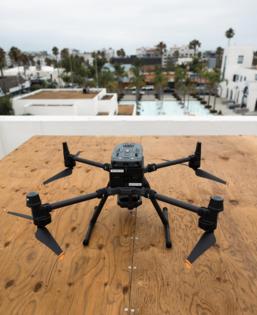When a 911 call comes in California, a drone might arrive before police do
Published in News & Features
SAN DIEGO — When a 911 call for police comes in the western reaches of Oceanside, there’s a chance that the first emergency responder to reach the scene will be a drone.
Oceanside is rolling out what is known as a “drone as first responder” program. It’s a 13-month test run, paid for with a state grant.
Under the program, when an emergency call for help comes in, police can scramble and get a drone up before officers arrive at the scene. It allows police to see just what sort of situation officers are about to roll up on.
Drones are pretty common in law enforcement, and Oceanside police have used them for nearly a decade. The department has 14 officers qualified to use drones, but they must be on scene to use them. That means they must drive up to the location before they can launch the drone. And the officer must be able to keep their eyes on the flying camera.
Not so for the “drone as a first responder” program. The officer does not have to be at the scene, and they don’t have to have eyes on the drone as it flies.
That’s a dramatic difference. Flying a drone beyond where the pilot can see it requires approval from the Federal Aviation Administration. The Oceanside Police Department has four FAA-certified drone pilots, all of whom are sworn police officers.
With permission to fly drones farther than the pilot can see it, police now have the ability to get one in the sky seconds after an emergency call comes in — even before an officer is dispatched.
The first-responder drone is based at City Hall. It can fly down to the city’s border with Carlsbad and north to the border with Camp Pendleton. And it’s a pretty quick flight to reach the beach or the pier — much quicker than a police officer can get there in summer traffic. Police said they can also fly it at night.
Watching a demonstration of the new drones in flight Wednesday, police Chief Taurino Valdovinos said the situational awareness they provide is “invaluable.”
“It’s an officer who’s watching the video and can provide real-time information to responding officers who are actually going to be on scene. That is helpful and beneficial for us,” the chief said.
Critics of police use of drones as first responders cite mass surveillance concerns, and fear that the drone gives police an overhead eye that sees everything beneath it as it flies to a potential crime scene. Asked about that, Oceanside police said their drones do not look down but more toward the horizon as they fly, then focus on the ground on arrival at the scene.
Police also say the drones are dispatched in response to active calls, not used for surveillance. “It’s call for service and back, call for service and back,” Valdovinos said.
The department has posted an online portal for people to see when and where the drone has been deployed. It also indicates the reason for the deployment and provides a map of the route.
The city is using a nearly $265,000 state grant to kickstart the program, which includes buying the drones and associated gear, from batteries to software, as well as having a dedicated staffer to watch the drone in flight as far as possible from the launch site atop City Hall.
However, the person atop City Hall is not the primary pilot. The controls are in the hands of a police officer back at the police headquarters on Mission Avenue, several miles away, watching a monitor.
Oceanside is the second local law enforcement agency OK’d for the drone-as-first-responder program. The first was Chula Vista, a pioneer in that arena. It was the only law enforcement agency to take part in a nationwide FAA test program to figure out how to safely integrate drones into national airspace.
The drones in Chula Vista have assisted in more than 3,600 arrests since 2018. And of the nearly 700 calls Chula Vista police sent a drone as a first responder to this year, officers were able to avoid responding about 10% of the time, according to the police department’s website.
©2025 The San Diego Union-Tribune. Visit sandiegouniontribune.com. Distributed by Tribune Content Agency, LLC.







Comments